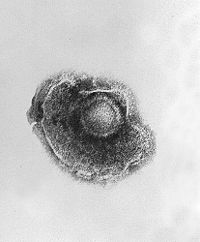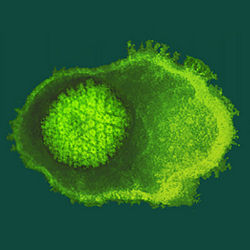Varicella zoster virus: Difference between revisions
imported>Svetlana Musheyev |
imported>Svetlana Musheyev m (→References) |
||
| Line 71: | Line 71: | ||
==References== | ==References== | ||
1.[http://vir.sgmjournals.org/cgi/content/abstract/67/9/1759?ijkey=b5856171af8c076b2ffdc4740f8981ee5187d321&keytype2=tf_ipsecsha | 1.[http://vir.sgmjournals.org/cgi/content/abstract/67/9/1759?ijkey=b5856171af8c076b2ffdc4740f8981ee5187d321&keytype2=tf_ipsecsha Davison, A. J., and J. E. Scott."The complete DNA sequence of varicella-zoster virus" ''Journal of General Virology''.1986. Volume 67. pp. 1759-1816.] | ||
Davison, A. J., and J. E. Scott."The complete DNA sequence of varicella-zoster virus" ''Journal of General Virology''.1986. Volume 67. pp. 1759-1816.] | |||
2.[http://www.ohioeye.org/pdf/2005annualmtg/MAS7A_Herpes.pdf Reinhart,W.J.. "Herpes Simplex Virus and Varicella Zoster Virus Anatomy, Microbiology, Epidemiology, and Diagnosis & Management of Ocular Disease" ''Ohio Ophthalmologic Society''.2005.] | 2.[http://www.ohioeye.org/pdf/2005annualmtg/MAS7A_Herpes.pdf Reinhart,W.J.. "Herpes Simplex Virus and Varicella Zoster Virus Anatomy, Microbiology, Epidemiology, and Diagnosis & Management of Ocular Disease" ''Ohio Ophthalmologic Society''.2005.] | ||
[http://www.ncbi.nlm.nih.gov/pubmed/8809466ordinalpos=1&itool=EntrezSystem2.PEntrez.Pubmed.Pubmed_ResultsPanel.Pubmed_DiscoveryPanel.Pubmed_Discovery_RA Arvin, AM. "Varicella Zoster Virus". ''Clinical Microbiology Reviews''. 1996. Volume 3. p.361-381.] | |||
4. [http://jvi.asm.org/cgi/content/full/80/19/9850 Peters, G. Tyler S Grose, C. Severine, A. Gray, M. Upton C. Tipples G.A.. "A Full-Genome Phylogenetic Analysis of Varicella-Zoster Virus Reveals a Novel Origin of Replication-Based Genotyping Scheme and Evidence of Recombination between Major Circulating Clades". ''Journal of Virology''.2006. Volume 80 No. 19 p. 9850-9860.] | 4. [http://jvi.asm.org/cgi/content/full/80/19/9850 Peters, G. Tyler S Grose, C. Severine, A. Gray, M. Upton C. Tipples G.A.. "A Full-Genome Phylogenetic Analysis of Varicella-Zoster Virus Reveals a Novel Origin of Replication-Based Genotyping Scheme and Evidence of Recombination between Major Circulating Clades". ''Journal of Virology''.2006. Volume 80 No. 19 p. 9850-9860.] | ||
Revision as of 00:04, 15 April 2008
Articles that lack this notice, including many Eduzendium ones, welcome your collaboration! |
| Chicken Pox | ||||||||||
|---|---|---|---|---|---|---|---|---|---|---|
 | ||||||||||
| Virus classification | ||||||||||
|
Description and significance
Varicella Zoster Virus usually comes in two forms. Upon the first infection, it produces red, leathery pustules and most often appears in children. This is generally known as "Varicella virus" or chicken pox. If the infection subsequently returns, it is then typically a painful red rash that encompasses most of the body. The small bumps of the rash develop pus, break open and darker crusts replace the blisters. This form of the disease is known as the "Herpes zoster" or shingles part, and mainly afflicts older people, or those with weakened immune systems.
Contrary to popular belief, the Varicella virus does not afflict chickens or any other animals. In fact, the only known hosts for VZV are humans, and people have been reporting cases of Varicella since ancient civilizations.
VZV is thought to be a virus which has coevolved with humans, and over the course of centuries, it has been fairly stable and only one serotype has been found. For Scientists in the 20th century, the importance of sequencing the genome lay not only in uncovering the molecular makeup of the virus, but also in developing a better understanding of how the viral genes function in pathogenicity, as well as its evoloutionary history, so a possible cure could be found. In 1986, Andrew J. Davison and James E. Scott published the entire DNA sequence of Varicella Zoster Virus in the Journal of General Viriology. With the help of M13-dideoxynucleotide technology, they discovered that the genome contained 124884 base pairs, with a total of 70 genes spread out evenly between the two DNA strands. They also compared the amino acid sequences of VZV to that of the Herpes Simplex Virus I, another virus of the subfamily Alphaherpesvirinae , and the striking similarities indicate a common ancestral origin.[1] Since the sequencing of its genome, there have been major developments in trying to prevent Varicella Zoster infection, including a succesful vaccination.
The Virus was first isolated by Dr. Thomas Weller in 1949, from the vesicular lesions of the Chicken Pox and Shingles pustules, and was grown in vitro, in tissue culture. Dr. Weller's research also proved that there was a connection between Varicella and Herpes Zoster virus, namely that Varicella was the causative agent for subsequent reactivation of Herpes Zoster Virus. He was a Nobel Laureate in 1954 for his work in isolating Varicella Zoster Virus, Cytomegalovirus, Mumps. Rubella and Poliomyelitis Viruses in human tissue cultures.
Genome structure
The diameter of Varicella Zoster Virus is about 150-200nM, and has approximately 125,000 base pairs,which incidentally is the smallest of the herpes virus genomes. VZV may encode up to 75 proteins, 70 of which are homologous with Herpes Simplex Virus I. [2] The virion has an icosahedral nucleocapsid made up of 162 capsomeres, and a protein covering separates the nucleocapsid from the lipid envelope that contains the viral glycoproteins. The core consists of a linear, double stranded DNA genome. The Molecular mass of the genome is 80 x 106 daltons, and it contains about 71 open reading frames (ORFs). The infection will bring out the immunoglobulin G, immunoglobulin M, and immunoglobulin A antibodies which will then bind to various viral proteins. [3]
It is an alphaherpes virus, so it has the charecteristic "unique regions" , the unique long and unique short regions, both containing inverted repeat regions. Similar to Herpes Simplex Virus I, it has 3' to 5' exonuclease DNA proofreading by DNA polymerase; this scrupulous proofreading creates minimum additions or deletions of nucleotides, and may be why the virus has been so invariable for hundreds of years. [4]
Cell structure and metabolism
Describe any interesting features and/or cell structures; how it gains energy; what important molecules it produces.
Ecology
Varicella Zoster interacts solely with humans because there are no animal hosts that have been identified so far.
Describe any interactions with other organisms (included eukaryotes), contributions to the environment, effect on environment, etc.
Pathology
The Varicella Zoster Virus causes disease in human hosts by inserting its gene into the host cell at the nasopharyngeal mucosa. It is highly contangious and may be transmitted from humans by contact with chickenpox blister fluid or by airborne infection. The incubation period can be anywhere from 14- 21 days, upon which red, itchy postules develop around the hosts body. Patient symptoms include rash, itching, fever and lethargy. In serious cases, such as for small children and immunocompromised adults, it can lead to severe skin infections, pnuemonia, brain damage or even death. After the varicella infection, it has latency in the sensory ganglionic neurons and may be reactivated years later as the Zoster virus, also known as shingles. Shingles produces painful blisters, and is characterized by a rash on one side of the body. Symptoms include hypersensitive skin, itching, and headache.
Application to Biotechnology, The Varicella Zoster Vaccine
The Varicella Zoster Vaccine is nationally recommeded for children starting from as early as 12 months old as a way to prevent getting Varicella Zoster. The vaccine has live, attenuated virus and are based on the Oka strain of varicella. Side effects of the vaccine can range from fever, mild rash to seizure, brain reactions, low blood counts and pnuemonia, but organizations such as the World Health Organization and Center for Disease Control and Prevention say that these severe problems are very rare, and the benifits of immunity from VZV outweigh the risks of getting the vaccine.
Current Research
Enter summaries of the most recent research here--at least three required
1. Herpes Zoster and Its Cardiovascular Complications in the Elderly – Another Look at a Dormant Virus by Tony S. Ma Tracie C. Collins Gabriel Habib Audrius Bredikis Blase A. Carabello This article mainly deals with the adverse effects of Herpes Zoster, the latent form of Varicella, on the cardiovascular healtg of geriatric patients. Numerous patients who had just suffered from Shingles subsequent heart blocks and other cardiovascular problems, and this study hoped to set up corelations between the two. Citing a previous study done by Head and Campbell, which indicates that the site of latency for zoster is in the dorsal root ganglion, they thought that it was the renal colic which stimulates the sensory ganglion to reactivate the Zoster. They continued to say that "The cardiac involvement could either be a result of a secondaryseeding of the pleural and pericardial space occurring through a cell-mediated transport of the VZV or a coincidental reactivation of VZV at the cardiac sympathetic/parasympathetic ganglia."(Tony, p. 4) In the case studies done, the researchers seemed to find that plueral and pericardial effusions were seen in a CT scan very close to when the outbreak of Zoster occured. However, further studies need to be done in order to provide a more conclusive correlation between Zoster and Cardiovascular problems.
2. http://search.ebscohost.com/login.aspx?direct=true&db=aph&AN=26916461&site=ehost-live Prevention of Varicella Recommendations of the Advisory Committee on Immunization Practices (ACIP)Mona Marin, MD, Dalya Güris, MD,* Sandra S. Chaves, MD, Scott Schmid, PhD, Jane F. Seward, MBBS [5]
3.Gilden DH: Varicella-zoster virus vaccine –grown-ups need it, too. N Engl J Med 2005; 352: 2344–2346.
References
Arvin, AM. "Varicella Zoster Virus". Clinical Microbiology Reviews. 1996. Volume 3. p.361-381.
5.[http://search.ebscohost.com/login.aspx?direct=true&db=cmedm&AN=16763386&site=ehost-live Tony S. Ma Tracie C. Collins Gabriel Habib Audrius Bredikis Blase A."Herpes Zoster and Its Cardiovascular Complications in the Elderly – Another
Look at a Dormant Virus"Cardiology.2006. Volume 107. p. 63-67.]
- ↑ Davison, A. J., and J. E. Scott. 1986. The complete DNA sequence of varicella-zoster virus. J. Gen. Virol. 67:1759-1816. http://vir.sgmjournals.org/cgi/content/abstract/67/9/1759?ijkey=b5856171af8c076b2ffdc4740f8981ee5187d321&keytype2=tf_ipsecsha
- ↑ Reinhart,W.J.
- ↑ .Arvin, AM. "Varicella Zoster Virus". Clinical Microbiology Reviews. 1996. Volume 3. p.361-381.
- ↑ Peters, G. Tyler S Grose, C. Severine, A. Gray, M. Upton C. Tipples G.A.. "A Full-Genome Phylogenetic Analysis of Varicella-Zoster Virus Reveals a Novel Origin of Replication-Based Genotyping Scheme and Evidence of Recombination between Major Circulating Clades". Journal of Virology.2006. Volume 80 No. 19 p. 9850-9860.
- ↑ Mona Marin
